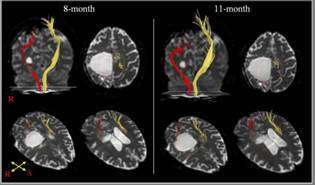Clinicians should pay attention to stroke patients who cannot walk at 3-6 month after onset

Gait dysfunction is one of the most serious disabling sequelae of stroke. Regaining gait ability in stroke is a primary goal of neurorehabilitation. Furthermore, gait is a less demanding motor function than hand function.
Stroke patients can walk when motor function is recovered in the proximal joint (hip and knee), at least to the degree of being able to oppose gravity. In general, most motor recovery after stroke occurs within 3-6 months after onset, and gait function usually recovers within 3 months of stroke onset. Therefore, clinicians need to look for the cause of gait inability and perform intensive rehabilitation for stroke patients who cannot walk after 3-6 months after insult. Sung Ho Jang and team from the College of Medicine, Yeungnam University (Daegu, Republic of Korea) reported on a stroke patient who showed delayed gait recovery between 8 and 11 months after the onset of intracerebral hemorrhage, which has been reported in the Neural Regeneration Research (Vol. 8, No. 16, 2013).
This 32-year-old female patient underwent craniotomy and drainage for right intracerebral hemorrhage due to rupture of an arteriovenous malformation. Brain MRI revealed a large leukomalactic lesion in the right fronto-parietal cortex. Diffusion tensor tractography at 8 months after onset revealed that the right corticospinal tract was severely injured. At this time, the patient could not stand or walk despite undergoing rehabilitation from 2 months after onset. It was believed that severe spasticity of the left leg and right ankle was largely responsible, and thus, antispastic drugs, antispastic procedures (alcohol neurolysis of the motor branch of the tibial nerve and an intramuscular alcohol wash of both tibialis posterior muscles) and physical therapy were tried to control the spasticity. These measures relieved the severe spasticity, with the result that the patient was able to stand at 3 months. In addition, the improvements in sensorimotor function, visuospatial function, and cognition also seemed to contribute to gait recovery.
As a result, she gained the ability to walk independently on even floor with a left ankle foot orthosis at 11 months after onset. This case illustrates that clinicians should attempt to find the cause of gait inability and to initiate intensive rehabilitation in stroke patients who cannot walk at 3-6 months after onset.
More information: Seo JP, Lee MY, Kwon YH, Jang SH. Delayed gait recovery in a stroke patient. Neural Regen Res. 2013;8(16):1514-1518.














